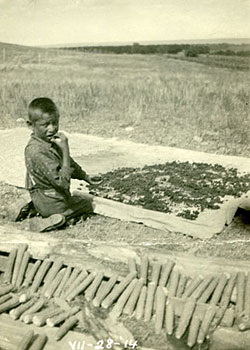
Edward Goodbird's son spreading corn
SHSND# 0086-343The planting was carefully organized to maximize moisture and reduce weeds. Six to eight corn kernels were planted in each hill. During the growing season, the soil was kept hilled around the corn plant to conserve moisture. Beans were planted between hills; squash grew between every 8 to 10 rows of corn. (Hidatsa, p. 48)
During the growing season women worked the ground from early until mid-morning. They made scarecrows from sticks and old buffalo robes to keep birds away from the crops. The women sang corn songs to encourage the plants to grow. for the Hidatsa believed that corn had a soul and responded to kindness. (Independence, p. 33; Hidatsa, p. 48)
Green corn (this was a field or flour corn type, not sugar or sweet corn) was harvested from mid-August until frost. It was a favorite food at this stage. The rest of the ears of all types were left on the stalk to mature. (Will, Corn, p. 115-116) At harvest, women picked the corn and piled it in the middle of the field. The next day, a crier from a men’s society called everyone to the field to begin the husking which took about 10 days. Young men went to the field singing and often courting a girl. The owner of the field prepared a feast of corn and meat for those who helped with the husking.
Most of the harvested corn was threshed, but the best was tied into braid of about 50 to 100 ears and placed on a scaffold next to the house to dry. Each family had to mind its corn supply to avoid running out before the next harvest. Corn was threshed into a sort of bin made of hides. Women beat the cobs to loosen the kernels. (Independence, p. 34-36)




